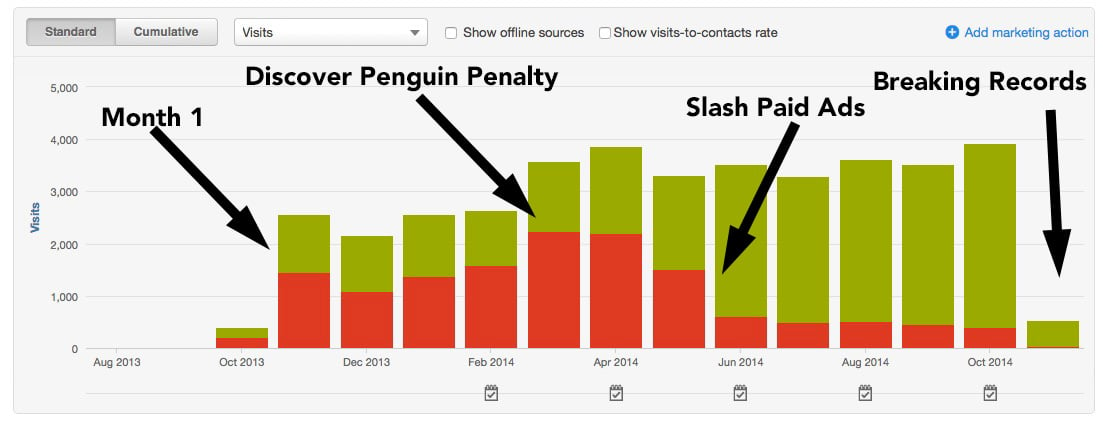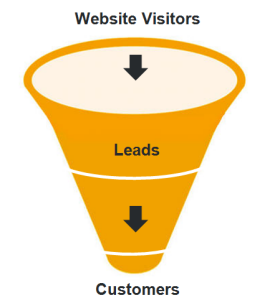Even the savviest of marketing strategists have second thoughts on the right campaign that will yield the highest return on investment (ROI). A lot of people look at their marketing investments on a short-term basis. They want results now, and they spend generously on whatever can hit their goals this month, quarter, or even year. But what long-term opportunities are they missing by being shortsighted.
Shortsighted marketers are like the man who had $300,000 and no place to live. Rather than spending on building a house, he rented an apartment. He was happy because he had a beautiful place to live on day 1. Meanwhile, another man in the same situation decided to invest most of his money in building a house; a long-term investment. It took several months to complete, and during that time, he wasn't living in nearly as much comfort as the first man. But five years later, he had a beautiful home paid for while the first man was once again homeless. Because, when you stop paying rent, you no longer get to live there.
Take PPC for example. Without a doubt, it works. This is why many brands spend a significant amount of their marketing budget on it. But at the end of the year, that budget is gone, along with the ads that money bought. The only way to get any more results is to spend even more money. When your budget runs out, the ads no longer work for you.
Meanwhile, investing in content and inbound marketing doesn't bring the instant gratification like paid ads, but it supports long-term growth goals. The money you spend on content keeps bringing returns. Most of all, you never have to spend on it again.
Smart brands are adopting this strategy -- either stopping paid ads altogether and reallocating that budget to content or doing a gradual shift by phasing our their ad budgets while shifting the spend to content marketing.

When trying to figure out ROI, think beyond the current budget. What can you do this year that will continue to bring results when you are making your budget for 2017? Or 2018?
Chasing the Elusive Marketing ROI
Regardless of industry and your marketing role, there will always be that nagging feeling when it comes to budgets. It's like waking up with a slight tickle at the back of your throat signaling the onset of a full-blown cold. You've got to do something before you find yourself trapped with misallocation, overspending, or like most marketers struggled with in 2015 -- failing to prove and measure ROI.
In this post, you will gain a marketing superpower -- that is be more clever in identifying marketing channels that will help you and your team accomplish optimized outcomes with fewer resources possible. No tea leaf reading involved!
Hop on to What Is a Good Marketing Budget for Small Business? If you think your budget is too little or too much.
Step 1: Understand exactly where you are.
Before you embark on the right fitness regimen this year, you've got to have goals, right? Before you go listing those goals, you have to know where you are exactly fitness-wise. Are you a total newbie with CrossFit? Or have you been doing marathons for two years?
It's a life hack referred to as the pivotal technique, and you can take the same approach for your marketing allocation in 2016.
Where are you now regarding your brand's growth?
You can either go the old-fashioned product life cycle route or hack your way through the stages of a B2B startup by Pardot's co-founder David Cummings.
Quick Tip:
In Cummings' B2B lifecycle, the second phase involves building a repeatable customer acquisition process. At this point, planning for marketing campaigns geared towards a steady customer base rather than a significant spike in sales should be a priority.
Therefore, this isn't the best time to rely on quick wins via PPC. Instead, you might want to invest in publishing cornerstone content or a launch pad website via growth-driven design.
Step 2: Get to know your prospects via the sales funnel.
This second phase complements your initial step in figuring out your brand's life cycle. After reflecting on the direction your brand is heading, it's high time you get to know your prospects more via the sales funnel.

Image Credit: HubSpot
- ToFu (Top of the Funnel) - Also known as learners, your prospects at this stage are mainly looking for information, doing research.
- MoFu (Middle of the Funnel) - Prospects who have it all figured out during the research phase become shoppers. Keep in mind that most shoppers may not be ready to make a purchase yet.
- BoFu (Bottom of the Funnel) - Once they've weighed down every possible pros and cons, shoppers become buyers.
To determine where most of your existing prospects are, ask the following questions:
- What's your average site visit per month?
- How many of these visits turn into leads?
- How many of these leads convert into a sale?
These questions are just examples. You can add your own by sitting down with your marketing and sales teams, or as Hubspot's Pamela Vaughan writes, digging deeper into the stages of your sales and marketing funnel.
Google Analytics is a great tool to kick-start your sales funnel analysis. Furthermore, a dependable CRM (Customer Relationship Management) such as HubSpot can help you ease your way to sales funnel optimization and lead generation. At Lean Labs, we're huge HubSpot fans!
Quick Tip:
Figure out a prospect's pattern of on-site activities through predictive lead scoring. Let's say that you've found out that a learner, on average, downloaded four eBooks before becoming a shopper. Therefore, your future budget should focus on eBook creation more than uploading informative videos.
Step 3: Devise a plan anchored on your findings in steps 1 and 2.
Once you're done with the 'where' in steps 1 and 2, move on to the 'what' and 'how.'
Based on what you've learned in using the pivotal technique and analyzing the sales funnel, list down your goals. This could be somewhere along the lines of:
- Grow email subscribers.
- Increase social media followers.
- Boost website traffic via search.
If you're still unsure about the specific goals you should aim for, mapping KPIs (key performance indicators) alongside your budget is the way to go. After all, you need to have a benchmark to measure ROI.
This is also the best time to decide whether or not to partner with an agency or maintain an in-house marketing team. Often, agencies have the advantage of having technical expertise such as design, content creation, and analytics.
Quick Tip:
The point of listing these particular objectives is to have a succinct picture of how you can distribute them throughout the year. You can allot a certain budget every month dedicated to content creation. Or choose to spend money on building brand awareness for the first three months and re-allocating the same budget on lead generation the next quarter.
Step 4: Track and measure your campaigns.
As a marketer, it's best to do your homework (measure) instead of resorting to pure guesswork.
Whether you're planning to blog twice a week or craft the perfect landing page to capture leads, having a system in place that will monitor and measure actual numbers is the foundation of informed budget decisions.
Currently, the tools dedicated to tracking everything -- from split testing to heat maps to promo codes -- are just a click away. You can also add in existing customer polls and website visitor surveys for further digging.
Word of warning when testing: Do not measure everything at once! Pick one focus area, run a test, analyze, and repeat. The ConversionXL folks wrote about what to test first if you're starting from scratch.
When measuring data, be wary of vanity metrics. As Shayla Price notes in a Kissmetrics post, typical marketing metrics like Facebook fans and press release shares may impress folks, but do not correlate to revenue.
Quick Tip:
Michael Litt of Content Marketing Institute recommends three easy ways to improve ROI with video content. Tracking attention span is one of these. If your data reveals that users, on average, are leaving after the first 10 seconds of the videos you just uploaded, consider spending more on other channels.
Step 5: Stay up to date.
These days, there's always something new that could boost ROI. Going with your gut may still work, but nothing beats hard data to figure out what works and what doesn't. Put simply, today's marketer should have a growth hacking mindset.
Doing What Works
Ultimately, adopting a test-and-learn approach to your marketing budget in 2016 allows for assets and campaigns that will truly delight your leads and customers. Likewise, the rest of the organization will be tickled pink because you have the numbers to back you up.
Which campaigns are you spending more in 2016? Which ones would you like to test the waters first?